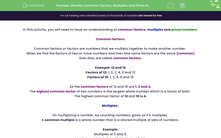In this activity, we will be finding common factors, multiples and prime numbers.
Common Factors
Factors are numbers that we multiply together to make another number.
When we find the factors of two or more numbers that are the same, then they are called common factors.
Example: 12 and 16
Factors of 12: 1, 2, 3, 4, 6 and 12
Factors of 16: 1, 2, 4, 8 and 16
The common factors of 12 and 16 are 1, 2 and 4.
The highest common factor of two numbers is the largest whole number which is a factor of both.
The highest common factor of 12 and 16 is 4.

Multiples
The multiples of a number are the numbers that form its times table.
A common multiple is a whole number that is a shared multiple of two or more sets of numbers.
Example
Multiples of 3 and 4:
Multiples of 3: 3, 6, 9, 12, 15, 18, 21, 24, 27, 30
Multiples of 4: 4, 8, 12, 16, 20, 24, 28, 32, 36, 40
The common multiples of 3 and 4 are: 12 and 24.

Prime Numbers
A prime number is a number only divisible by itself and 1.
So, prime numbers have only two factors.
Example
What are the prime numbers between 10 and 30?
Answer: 11, 13, 17, 19, 23, 29
These numbers have no factors except for the number 1 and the number itself.
That's a lot to remember, but it will become easier the more we practise.
Let's get started!







